PCM 1/32 Macchi C.202
|
KIT #: |
32-002 |
|
PRICE: |
$59.95 MSRP when new
|
|
DECALS: |
Eight Options |
|
REVIEWER: |
Tom Cleaver |
|
NOTES: |
Currently out of production |
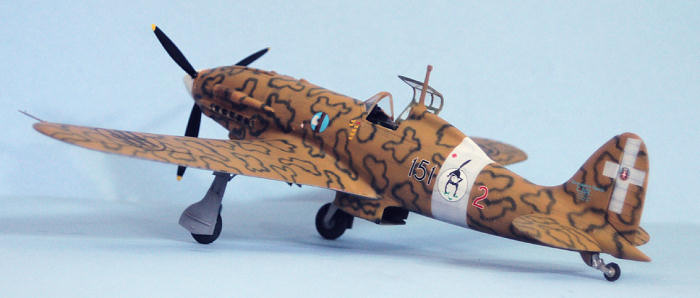
The failure of the Italian
aircraft industry to develop a high‑powered domestic aircraft engine led to the
situation where all the fighter
aircraft of the Regia Aeronautica after the Fiat C.R.32 were outperformed by
their opponents. It is nearly
impossible to look at the Macchi C.200 and realize that it had a pedigree in
Schneider Cup air racing history that was as important as that of the
Supermarine Spitfire, with its sire being the incredible Macchi C.72 racer, the
fastest seaplane racer to ever fly.
Unfortunately, the C.200 was saddled with the low‑powered Fiat A.74 radial and a
requirement that the pilot be provided maximum visibility, resulting in the
aircraft’s humpbacked appearance, so that all this aeronautical
DNA
appeared wasted. However, the next
development of the basic design regained all the grace and look of speed
associated with the M.52 and M.C. 72 racers Mario Castoldi had created.
All it
took to accomplish this was the replacement of the Italian engine with a German
Daimler‑Benz DB601A, one of the finest piston aero engines ever designed and
built, which Alfa‑Romeo had acquired a license to produce in November 1939.
Unfortunately, Alfa‑Romeo never seemed to get things right with their
version of the engin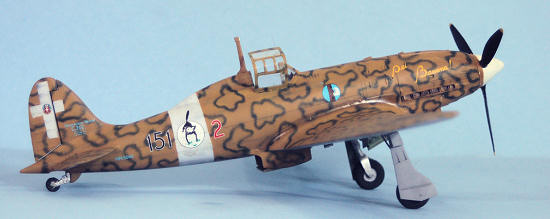 e
‑ the R.A.1000 R.C.41 Monsone (Monsoon) ‑ which presented nothing but
problems and a complete lack of mechanical reliability when produced, with a
production rate that never exceeded 50 a month.
This forced Macchi to rely on an ever‑dwindling and never reliable supply
of German engines for their fighter
e
‑ the R.A.1000 R.C.41 Monsone (Monsoon) ‑ which presented nothing but
problems and a complete lack of mechanical reliability when produced, with a
production rate that never exceeded 50 a month.
This forced Macchi to rely on an ever‑dwindling and never reliable supply
of German engines for their fighter
First flown on August 10,1940, with its
German engine providing in excess of 1,000 horsepower that increased top speed
from the C.200's 315 mph to 370 mph, and with a graceful, streamlined fuselage,
the Macchi C.202 was the immediate equal of such aircraft as the Supermarine
Spitfire and later the North American P‑51 in terms of overall performance.
It could more than hold its own with the P‑38 Lightning, and was superior
to the Hawker Hurricane, P‑40 Warhawk, and P‑39 Airacobra.
The Folgore could turn inside all its opponents including the Spitfire,
which was the only Allied fighter that could outclimb the Castoldi fighter. With
finger‑light aerodynamic controls and outstanding maneuverability, its only
fault was that its armament was too light: originally set at two 50‑caliber
machine guns with 400 rpg each mounted in the fuselage and firing through the
prop, this was supplemented in later production batches by the provision of a
single 30‑caliber machine gun with 500 rpg in each outer wing.
While the
C.202 Folgore (Lightning) could equal its opponents on an individual
plane‑vs‑plane level, the Italian aviation industry was incapable of anything
approaching real mass production.
Thus, between its appearance in the Spring of 1941 and the end of the Italian
fascist state in September 1943, only
1,200 C.202s, in 11 series
were produced in total. Of these,
Macchi produced 392, with the rest being built under license by
Breda
and
SAI
Ambrosini. Even with this, by the Spring of 1942 the Folgore outnumbered all
other fighters in the inventory of the Regia Aeronautica.
Delivery
of the first production aircraft, C.202 Series I, to 1º Stormo C.T., a
specially formed conversion unit in
Udine,
commenced during the summer of 1941.
The C.202s made their combat debut on the Libyan front on November 25,
1941. Two further Folgore‑equipped Gruppi arrived in
Libya
following the failure of the second
British
Western
Desert
offensive that December. The Folgore’s next appearance was over
Malta
with the 51º Stormo C.T. in
early 1942, flying from bases in
Sicily.
Beyond service in
North Africa
and
Sicily,
the C.202 was in limited service on the Eastern Front with the 21º Grupo
after November 1942, where a total of 18 C.202s operated with a force of 48
C.200s. Together with the three
Squadriglia of C.200s, the Folgores ac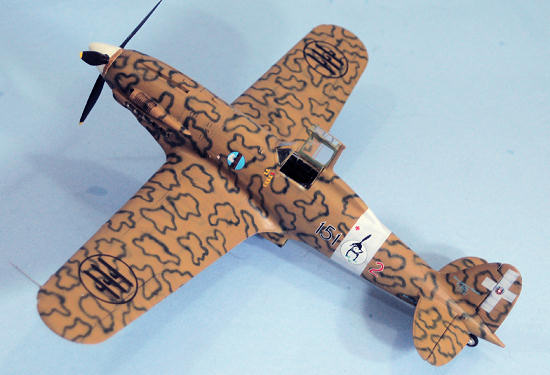 hieved
an 88 to 15 victory/loss ratio by the time the unit was withdrawn from the
Eastern Front in February 1943 following the defeat at
Stalingrad.
hieved
an 88 to 15 victory/loss ratio by the time the unit was withdrawn from the
Eastern Front in February 1943 following the defeat at
Stalingrad.
Following the Armistice in September
1943, C.202s were used by both the Italian Co‑Belligerent Air Force operating
with the Allies, and with the Aviazione Della R.S.I. which continued to
operate with the Germans. The C.202
was used as a trainer in the north, while it was operated in limited service in
the South while engines were available, flying with the Balkans Air Force.
After the war, 41 C.202
airframes were fitted with license‑built Daimler‑Benz DB 605 engines and sold to
Egypt
as C.205 Veltros.
The C.202 illustrated both the promise and the problems of the Italian
aviation industry. As a design, it
was excellent, and the equal of its opponents.
Unfortunately the industrial base of
Italy
could not provide the airplane in the numbers needed.
Sergente Maresciallo Ennio
Tarantola:
Ennio Tarantola was born in
Como
on January 19, 1915. During his youth, he worked as a banana seller for the
Colombo‑Poggi firm at Piazza Cavour, where he gained the nickname “Banana,”
which he used for the rest of his life.
Tarantola joined the
Regia Aeronautica a Sergente Pilote in September 1936 and volunteered
for service in the Spanish Civil War, where he flew with the XVIth “La
Cucaracha’ Gruppo C.T., equipped with the Fiat CR.32.
He claimed his only victory,
a Polikarpov I-15 “Chato” on
January 20, 1938,
and was awarded two Medaglie d’Argento al Valore Militare for his Spanish
service. Returning to
Italy,
he joined the 155a Squadriglia, equipped with the CR.32.
Tarantola was one of the
first Italians trained to fly the Ju-87B Stuka, known to the Italians as the “Picchiatelli.”
He flew the Ju-87 operationally with the 209th and 239th
Squadriglie Autonoma Bombardamento a Tuffo from March to October
1941. He participated in the
June 29, 1941
attack by Italian and German dive‑bombers on the destroyer HMAS Waterhen
and was one the pilots who claimed a hit on the ship.
HMAS Waterhen was abandoned,
then a salvage party from HMS Defender went on board.
The ship was sunk during an air attack while being towed by HMS Defender
on June 30, during which attack Tarantola was shot down, surviving in his dinghy
for 18 hours before being rescued.
Tarantola requested a return
to fighters and on
November 4, 1941,
he joined the 151st Squadriglia of the 20o Gruppo C.T., which
was equipped with Fiat G.50s and based in
Tripoli.
On
December 5, 1941,
he claimed a Curtiss P-40 for his second victory.
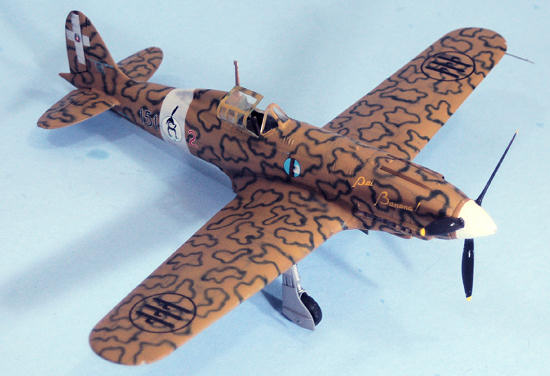 At the end
of the month, the 20th Gruppo returned to
Italy
to re-equip with the then-new Macchi C.202.
Assigned to the 51st Stormo, the unit was transferred to
Sicily
for the attack on
Malta
in the spring of 1942. Tarantola’s
airplane was marked with the inscription “Dai Banana!” (“Come on,
Banana!”).
At the end
of the month, the 20th Gruppo returned to
Italy
to re-equip with the then-new Macchi C.202.
Assigned to the 51st Stormo, the unit was transferred to
Sicily
for the attack on
Malta
in the spring of 1942. Tarantola’s
airplane was marked with the inscription “Dai Banana!” (“Come on,
Banana!”).
Beginning in July, Tarantola
began to increase his score, shooting down a Spitfire on July 1, and a second on
July 4.
Over
Malta,
Tarantola often flew as wingman to Squadriglia commander Capitano
Furio Niclot Doglio, making shared claims with Niclot over Spitfires on July 7
and 10; in the latter fight, his C.202 was badly shot-up, but he was able to
return to base. He continued flying
with Niclot, scoring another Spitfire on July 25.
On July 27, Niclot was shot
down and killed by George Beurling in a combat in which Tarantola was wounded.
Tarantola claimed a Spitfire shot down on
October 11, 1942,
one of four claimed that day by Italian pilots, though the RAF records show no
losses, while the Italians lost one C.202 shot down by Spitfires.
On October 14, flying a second
mission over
Malta,
Tarantola’s airplane was hit so badly that he had to parachute into the sea off
the Sicilian coast.
20th
Gruppo was pulled back to Ciampino Sud outside
Rome
in December. After five months of
rest and re‑equipment they moved to Capoterra,
Sardinia,
in May 1943. On June 28, Tarantola
claimed a P‑40, and claimed a P‑38 on July 30.
On August 2, 1943 Tarantola
took part in a major fight over Sardinia, flying five missions that day against
P‑40s of the 325th
Fighter Group and P‑38s from the 14th Fighter Group, claiming two
P-38s shot down over Capo Pula.
After the Italian surrender
Tarantola joined the Aeronautica Nazionale Repubblicana (ANR), flying
with the Squadriglia Complementare “Montefusco‑Bonet”, where he flew the
Macchi C.205 and the Fiat G.55. On
April 24, 1944, seven G.55s and two C.205s - one G.55 flown by Tarantola -
intercepted 117 B‑24s of the 304th Bomb Group, escorted by 45 P‑47s
of the 325th FG, that attacked the Aeritalia aircraft factory in
Turin. As they
attacked the bombers, the ANR fighters were jumped by P‑47s. Three G.55s
were shot down and Tarantola parachuted after being badly wounded; he did not
return to flight status until the summer of 1945.
During the war, Tarantola
claimed on victory in Spain and 11 in wartime service with the Regia Aeronautica
and the ANR. He received a third
and fourth Medaglie d’Argento al Valore Militare, two Medaglie di
Bronzo and five Croce di Guerra, and was promoted twice “for war
merits.” He remained in the Italian
Air Force until the early 1970s, retiring to Cesenatico where he died on July
30, 2001.
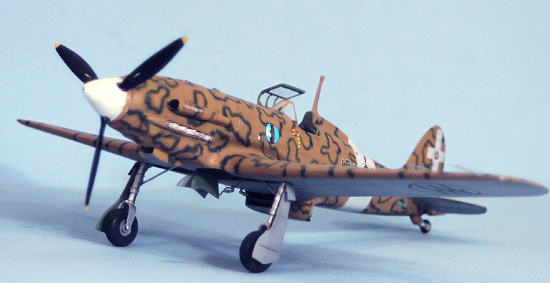 PCM’s Macchi C.202 Folgore was the second major release by this
company in 1/32, following the release of their C.200 Saetta, and
followed soon thereafter by the C.205 Veltro.
These were the last PCM kits done by MPM.
PCM’s Macchi C.202 Folgore was the second major release by this
company in 1/32, following the release of their C.200 Saetta, and
followed soon thereafter by the C.205 Veltro.
These were the last PCM kits done by MPM.
The first C.202 I got in 2006 ended up in the round file when the resin
parts turned out to be too small to fit the rest of the model.
I had already noted that MPM had tried for too much commonality with the
C.202 and C.205 kits, since the horizontal stabilizers and elevators were for
the C.205 and differed in significant visual detail from the C.202, which used
the same ones as the earlier C.200.
Additionally, the spinner was undersized and would not match up with the forward
fuselage, in addition to being the wrong shape for the C.202, being more for the
C.205.
I ran across this kit shelf-sitting at a local hobby shop here in Los
Angeles last fall, and decided to pick it up.
I had a lower forward fuselage part from the 21st Century Toys
kit, which would likely be the right size if the resin part was still undersize.
As it turned out, this kit had a part that fit.
These kits are by MPM, and the fit stinks (as it too often does with MPM
kits). I had to dremel out the
interior of the fuselage in the vicinity of the cockpit to allow the very nice
resin cockpit to fit in the fuselage.
As mentioned, the resin lower nose part fit, and only needed some Mr.
Surfacer to fill the joint.
The cockpit was painted with Xtracrylix British Interior Green, which is
a good approximation of the Italian color.
There is lots of nice detail to the cockpit, in both resin and photoetch.
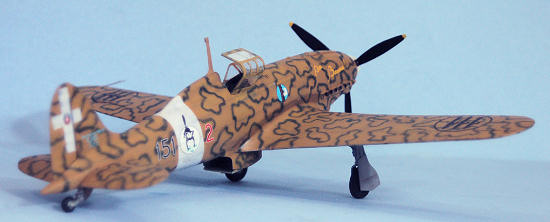 The wing sub-assembly was difficult, and I had to do a lot of trimming of
the wheel well bulkheads to get them to fit inside the fuselage.
Once I did, there were huge gaps on the upper wing/fuselage joint.
I ended up using some Evergreen rod to fill the gaps.
I also needed two very large rubber bands to wrap wingtip-to-wingtip
around the wing to bring up the dihedral to the correct amount. I applied
copious amounts of cyanoacrylate glue over the joint after the Tenax set up,
hitting the C-A with accelerator, to strengthen the joint and maintain the
dihedral. A considerable amount of
Bondo putty and Mr. Surfacer was used to get the joints smoothed over, after
which I rescribed the lost surface detail.
The wing sub-assembly was difficult, and I had to do a lot of trimming of
the wheel well bulkheads to get them to fit inside the fuselage.
Once I did, there were huge gaps on the upper wing/fuselage joint.
I ended up using some Evergreen rod to fill the gaps.
I also needed two very large rubber bands to wrap wingtip-to-wingtip
around the wing to bring up the dihedral to the correct amount. I applied
copious amounts of cyanoacrylate glue over the joint after the Tenax set up,
hitting the C-A with accelerator, to strengthen the joint and maintain the
dihedral. A considerable amount of
Bondo putty and Mr. Surfacer was used to get the joints smoothed over, after
which I rescribed the lost surface detail.
I filled in the mass balance on the elevators, and rescribed the
elevators correctly for the C.202, and installed these.
The resin radiator mostly fit, though I needed a lot of Bondo and Mr.
Surfacer to smooth the joint where the rear of the radiator assembly fits to the
fuselage just aft of the wing.
I ended up using a spinner for a Rotol prop from a Hasegawa Spitfire V
kit, which I filled with cyanoacrylate and then reshaped, to get a spinner that
would both look right and fit to the nose with the correct size.
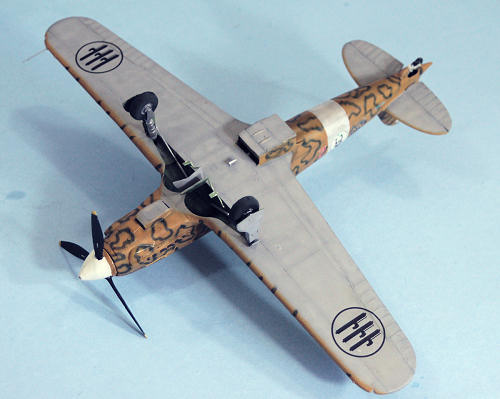 Painting:
Painting:
I pre-shaded the model with airbrushed flat black, then painted the white
fuselage band and vertical fin, which I masked off.
I used Tamiya “Sky Grey” for the lower color, and a mixture of Tamiya
“Flat Earth” and “Flat Yellow” for the Nocchiola Chiaro 4, and a mixture
of Tamiya “Black Green” and “Deep Green” for the Verde Oliva Scuro 2.
The “smoke rings” were freehanded with my airbrush; I don’t know why so
many modelers are afraid of doing this scheme themselves and feel they have to
resort to decals - any look at any Italian airplane with this camouflage will
reveal the smoke rings are not nice and neat, they were applied with spray guns
with no attempt at neatness or uniformity.
When this was dry, I gave the model a coat of Future.
Decals:
The decals are the best part of the kit, being printed by Cartograf.
They are in perfect register, and go on without any difficulty.
I gave the model an overall coat of Xtracrylix Flat Varnish, then
assembled and attached the landing gear and attached the prop and canopy in the
open position. I applied exhaust
stains with Tamiya “Smoke.”
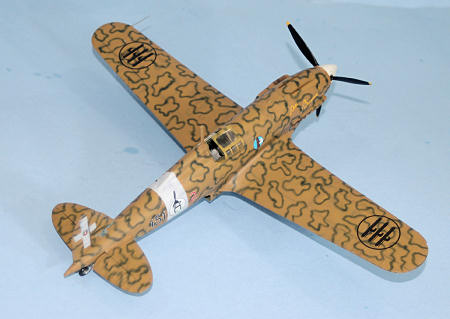 Definitely not an easy kit, but the result looks good.
I did this same airplane with the 21st Century Toys kit in
2007, using parts from the failed PCM kit.
This kit looks overall better than the 21st Century kit in
terms of detail. I personally think
the Macchi C.202/205 are the best-looking Italian fighters of the war, and this
kit catches that.
Definitely not an easy kit, but the result looks good.
I did this same airplane with the 21st Century Toys kit in
2007, using parts from the failed PCM kit.
This kit looks overall better than the 21st Century kit in
terms of detail. I personally think
the Macchi C.202/205 are the best-looking Italian fighters of the war, and this
kit catches that.
Review kit courtesy of my
wallet.
Tom Cleaver
January 2010
If you would like your product reviewed fairly and quickly, please
contact
me or see other details in the
Note to
Contributors.
Back to the Main Page
Back to the Reviews Index Page


 e
‑ the R.A.1000 R.C.41 Monsone (Monsoon) ‑ which presented nothing but
problems and a complete lack of mechanical reliability when produced, with a
production rate that never exceeded 50 a month.
This forced Macchi to rely on an ever‑dwindling and never reliable supply
of German engines for their fighter
e
‑ the R.A.1000 R.C.41 Monsone (Monsoon) ‑ which presented nothing but
problems and a complete lack of mechanical reliability when produced, with a
production rate that never exceeded 50 a month.
This forced Macchi to rely on an ever‑dwindling and never reliable supply
of German engines for their fighter hieved
an 88 to 15 victory/loss ratio by the time the unit was withdrawn from the
Eastern Front in February 1943 following the defeat at
hieved
an 88 to 15 victory/loss ratio by the time the unit was withdrawn from the
Eastern Front in February 1943 following the defeat at  At the end
of the month, the 20th Gruppo returned to
At the end
of the month, the 20th Gruppo returned to  PCM’s Macchi C.202 Folgore was the second major release by this
company in 1/32, following the release of their C.200 Saetta, and
followed soon thereafter by the C.205 Veltro.
These were the last PCM kits done by MPM.
PCM’s Macchi C.202 Folgore was the second major release by this
company in 1/32, following the release of their C.200 Saetta, and
followed soon thereafter by the C.205 Veltro.
These were the last PCM kits done by MPM.

